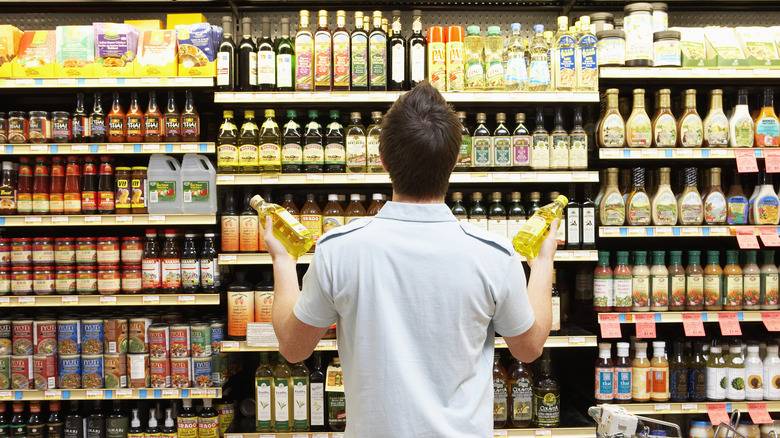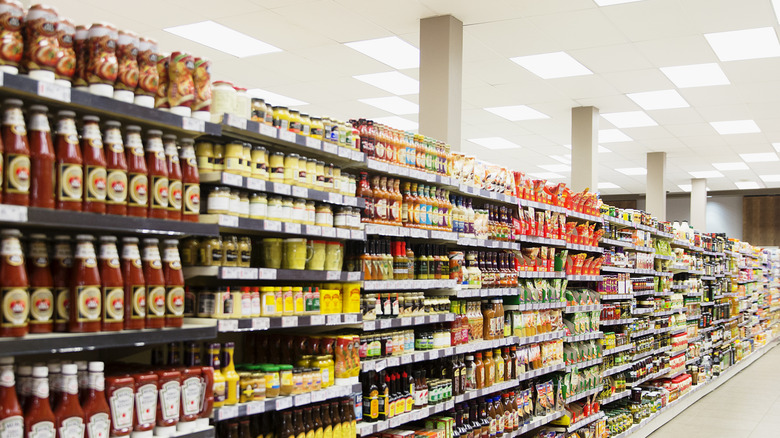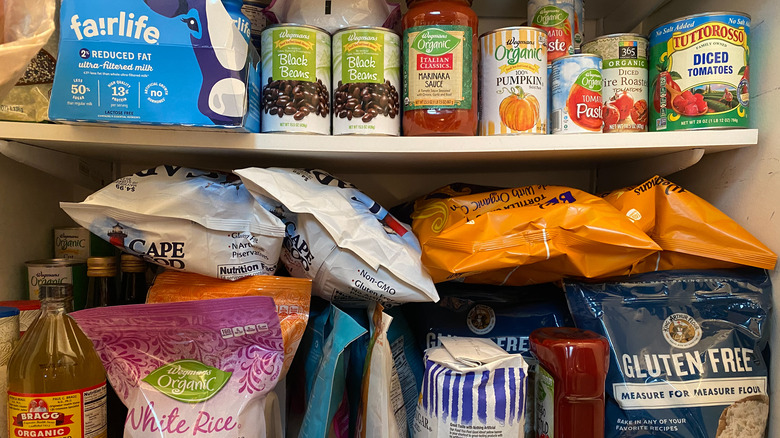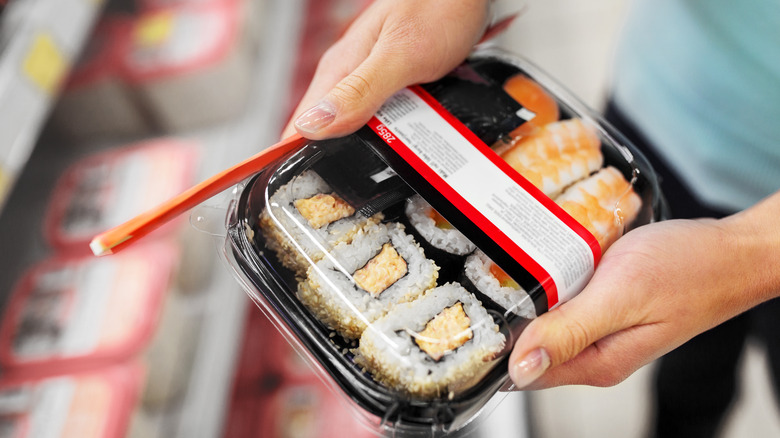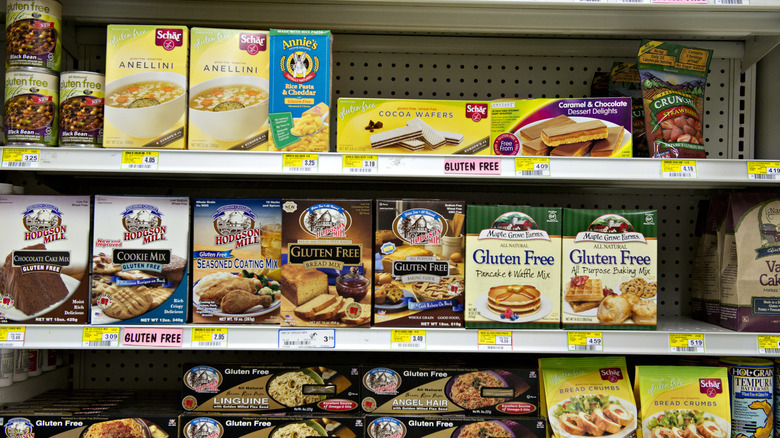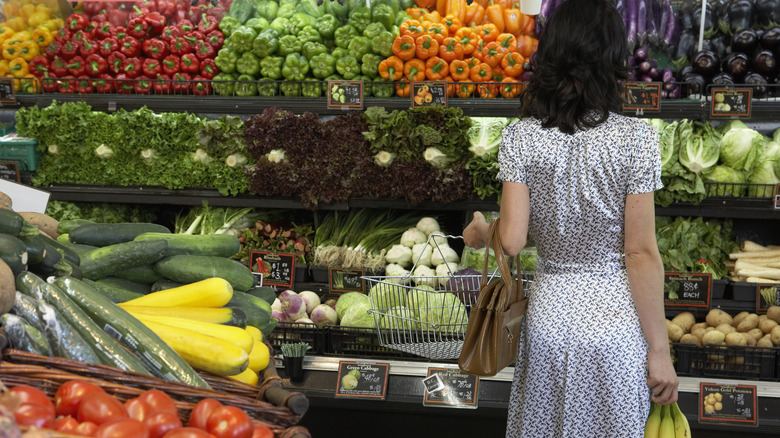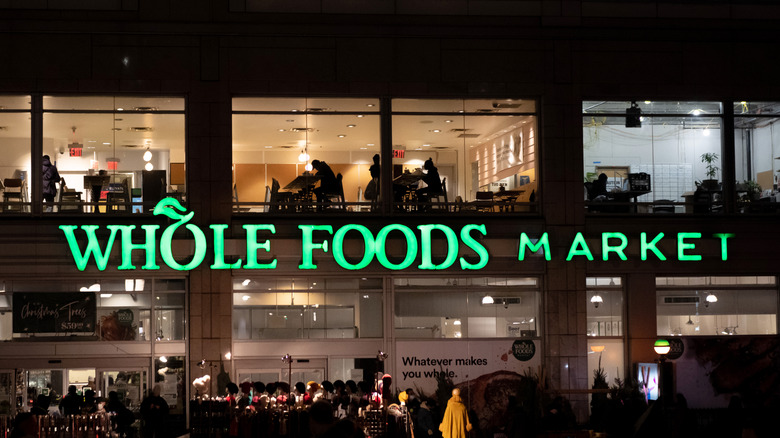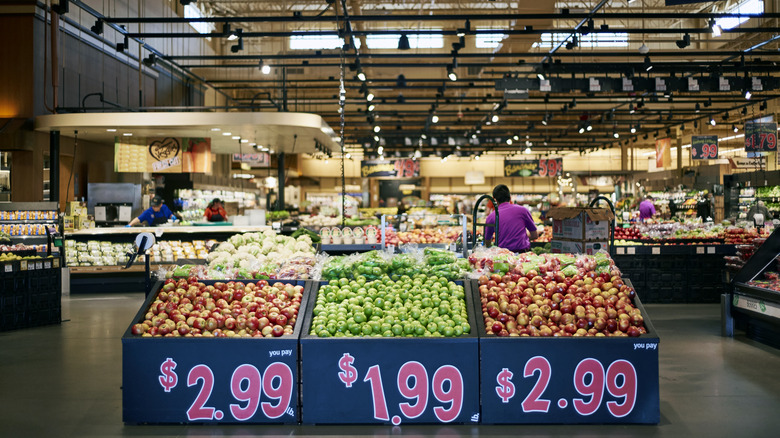Whole Foods Vs. Wegmans: Which Is The Better Option For You?
Grocery shopping is exhausting. Not only do you have to make so many choices inside the store, but you have to decide where to shop in the first place. Whole Foods and Wegmans are two grocery chains that receive great love and attention, but we wanted to make it easier for you to know where to shop.
Whole Foods is an Austin-based company that opened its first store in 1980. The company expanded over the years to rack up over 460 locations by 2017 when the shocking news came that Amazon would be purchasing the company for $13.4 billion (via the New York Times). The idea of an upscale grocer merging with the massive online retailer perplexed many people, but five years later, the acquisition shaped a new era for the grocery chain.
Wegmans, on the other hand, has remained a family-owned company since 1916. With origins in Rochester, New York (the city where its headquarters still sit) third and fourth-generation of Wegmans family members currently run the company. They have grown more slowly than Whole Foods, but they have gained a very loyal following. Not many grocery stores can claim to have a fanbase like Wegmans can.
We came up with this list of assessments to help you determine whether Whole Foods or Wegmans is the better grocery store for you. Neither location may check all of your boxes, but after reviewing these factors, you should be able to decide for yourself which store is right for you.
Average prices
Price may not be the sole factor of consideration when choosing a grocery store, but it is significant. Consumers value aspects like convenience and selection, but when inflation hits, grocery habits change. A 2022 survey conducted by The Harris Poll shows that 90% of respondents are concerned with food prices and are taking actions such as making fewer grocery trips and buying more generic brands.
Let's evaluate how these two grocery stores rank in terms of pricing. Whole Foods has been referred to as "whole paycheck," but is this nickname earned? A 2019 Business Insider article reported Whole Foods to be the most expensive overall in a direct comparison with Wegmans and ShopRite, but not all items were the most expensive at this chain. Whole Foods had the best price for kale, organic carrots, Haas avocados, and cheddar cheese.
Wegmans is not the cheapest grocery store, and in some departments, it can be almost as expensive as Whole Foods. Consumers' Checkbook details how produce costs are on par at each store, but meat and overall prices are lower at Wegmans. When compared to the average grocery prices, their research supports that a consumer would spend $390 more per year at Wegmans but $2,990 more at Whole Foods. When Amazon purchased Whole Foods in 2017, it claimed lowering prices would be a priority. Tech Crunch reports that the grocery chain did implement multiple rounds of price cuts, but it still ranks as one of the most expensive grocery options.
Product selection
Do you get overwhelmed by the sea of products in grocery stores, or do you like having a lot of choices? Your answer may determine which chain is better suited for you.
Wegmans has been praised for the abundance of options on its shelves. The supermarket chain offers 50,000 to 70,000 products plus over 4,000 organic items. One customer proclaims on Trustpilot that Wegmans "literally" has it all, including great organic produce and obscure ingredients you can't find elsewhere. The wide selection is a common accolade from its fans. Comparatively, Whole Foods has 20,000 available products (via Supermarket News). If 20,000 food items still seems like more than you could ever imagine, let's compare how these numbers translate to your tastes.
Whole Foods has historically not sold big mainstream brands like Kraft or Nestlé, but since the Amazon takeover in 2017, they have added 3,000 new brands. However, they have opted for more local brands over big companies (via CNBC). Whole Foods will have more choices when you want to support small local businesses, but when you get that craving for Cheetos or Coca-Cola, Wegmans will be there for you. Whole Foods cannot beat Wegmans' overall selection.
Store brand products
Both supermarkets have a strong store brand presence, which shouldn't come as a surprise. Grocery stores benefit more from selling private-label products. The profit margin for store-brand items is 35% compared to 26% for name brands (via Supermarket Perimeter). Supermarkets have an obvious incentive to get you to buy their branded items, but when they are good quality, it can be a win-win situation for producers and consumers.
At Whole Foods, the 365 brand products will typically get you the best deal. Not only are they lower in price, but you can find them frequently on sale and get even better deals if you have a Prime membership. Whole Foods has over 3,500 products in its store brand line, including staples like bread and produce, sauces, spreads, and cleaning supplies. Some of the best 365 products are olive oil, jarred pesto, almond butter, and riced cauliflower.
365 brand products make up less than 20% of the existing products in Whole Foods. In 2021, a Rochester area reporter broadcasted that half of all products on Wegmans' shelves were their own brand, double the 20% to 25% national average. One Wegmans super-fan swears by its branded products, especially sparkling water, organic pasta, and olive oil (via Real Simple). Others complain that they are being forced to buy the store brands. One Facebook user frustratingly commented that 90% of products on the shelves were store brand.
Prepared foods
Supermarkets aren't just a place to buy raw ingredients. Chains like Whole Foods and Wegmans have built out prepared food programs to cater to people on the move. Prepared foods may include previously cooked meals that consumers will reheat and eat or hot foods and foods that need no further preparation that are ready to eat. Both chains have restaurant-style seating, allowing people to dine in the store, whether it's a quick trip on their lunch break or as part of their grocery shopping experience.
Each chain has numerous options for prepared meals, so how do they compare in quality? Wegmans has an almost cult-like following, and that includes their Market Café. Reader's Digest lists subs and sushi as the top two things to buy in the whole store. No one claims that Wegmans' prepared foods are cheap, but many customers profess their appreciation of the variety and quality of offerings, such as one reviewer on Trip Advisor, who gets lunch at the café before their weekly shopping.
Prepared foods are listed among the things you shouldn't buy at Whole Foods. Price alone seems to be a huge deterrent. Wegmans sushi prices, for example, are considerably cheaper than comparable products at Whole Foods. Still, Whole Foods has gained esteem for their irresistible mac and cheese and chicken from the hot bar, and people are willing to spend the money on those items (via Greatist).
Alternative food options
Having special dietary needs used to be a nightmare when it came to grocery shopping. Despite the broadened availability, it can still be stressful trying to find what you need. Whether you are vegan or need to avoid foods containing gluten, dairy, soy, or nuts, you often have to do research to know where to shop.
A 2008 study from the Canadian Journal of Dietetic Practice and Research shows that gluten-free products are an average of 242% more expensive than standard products. You can still expect to see these products hit your wallet harder at both stores, as well as with many plant-based alternatives. Let's see how these stores compare so you can seek the best deals. Keep in mind that prices can differ by location.
Wegmans offers the best price for name-brand dairy-free cheese, while Whole Foods' store brand is cheaper. Wegmans has lower prices overall on milk substitutes, but if you are a fan of Oatly, Whole Foods has them beat. Both stores offer a variety of store-brand gluten-free products, including flour, bread, pasta, desserts, and frozen items, but if you want name brands like Bob's Red Mill, Wegmans is a few dollars cheaper. Whole Foods and Wegmans have both developed their own plant-based meat alternatives (roughly equal in cost), but if you want to stick with brands like Beyond and Impossible, Wegmans has the best price. Overall, there is no clear winner. These chains have a good selection of alternative foods, and the best price varies by product type.
Quality of products
If you have to pay more to shop at these stores, you likely expect superior quality to come with the price. In a Consumers' Checkbook survey, 88% of respondents rated Wegmans produce as having "superior" quality, with 85% saying the same for Whole Foods. They received similar feedback on meat. Where these stores differed was on overall quality where Wegmans received a 90% rating compared to 66% for Whole Foods.
There is no shortage of customer feedback available online, both positive and negative. One satisfied Wegmans customer said on She Speaks that the produce and fish selection are excellent. A Whole Foods shopper proclaims on Influenster that every product at the store is of high quality.
Still, you can find plenty of disgruntled customers. Whole Foods has a 1.9 overall rating on Trustpilot with 63% of their reviews being 1-star (and only 14% 5-star). Wegmans' Trustpilot rating is barely higher at 2.2, but their 1-star and 5-star ratings are 42% and 40%, respectively. Many of the 1-star reviews from both supermarkets complained about specific products or a single bad experience.
Number of locations
When it comes to broad accessibility, Whole Foods is the clear winner. Despite closing six stores in 2022, the Austin-originated chain has more than 500 locations nationwide (via Boston 25 News). According to Scrape Hero, 43 out of 50 states have at least one Whole Foods store.
Wegmans currently has 109 stores and can be found in only nine states, with New York having the highest concentration. The Rochester-based company most recently opened an 84,000-square-foot store in Wilmington, Delaware, making it the first for this state (via Winsight Grocery Business). Wegmans strategically only opens three stores each year. One store that is scheduled to open in 2023 is an 82,000-square-foot location in Manhattan, the first in this New York borough (via Time Out).
Not everyone is lucky enough to live near a Wegmans, but that doesn't stop some diehard fans, like one reviewer on She Speaks who drives 90 minutes every month to get their groceries. Even so, there is only so far one can go for food shopping. A large chunk of the population would need a plane ticket to get to a Wegmans. Although Whole Foods has been associated with gentrification causing questions about the effects of rent costs, many more people have physical access to their stores than the New York regional chain.
Store design
If you have yet to experience Wegmans and find yourself wondering, "How amazing could a grocery store possibly be?" you'd be surprised by the awestruck reaction of first-time shoppers. After their initial visit, one Twitter user questioned if Wegmans was a supermarket or an amusement park, adding that they were amazed at first sight. This is not a stand-alone reaction. A Business Insider article describes Wegmans as a "fantasyland."
Reactions like this probably have Wegmans' store designers jumping for joy. The company admits on its website that they want you to feel like you are at a European open-air market with "dazzling displays" of fresh produce, artisan bread, meat, seafood, imported cheeses, international foods, and more. Their stores range from 75,000 to a whopping 140,000 square feet. The average size of the American grocery store has been on the rise in recent years, reaching over 51,000 square feet in 2021, but it is still far below the smallest Wegmans (via FMI).
Whole Foods real estate guidelines call for retail locations between 25,000 and 50,000 square feet for new stores, but the average size sits at about 40,000 square feet (via Statista). Smaller doesn't necessarily mean worse. Whole Foods locations are also intentionally designed to "disrupt" the grocery shopping experience (via KCRW). Reviews of the store design differ greatly by location, but the larger, well-stocked stores with additional features like a coffee stand and an alcohol section seem to impress people the most.
Ordering online
One adaptation of the pandemic that is not likely to go away is the increased volume of online grocery shopping. Having options for online ordering has become a bit of a necessity for major grocery chains to keep up with demand for all those who desire contactless grocery delivery.
Whole Foods did have a relationship with Instacart several years ago, but this ceased in 2018, a year after the Amazon acquisition (via Tech Crunch). Now their online ordering is handled internally. You can order groceries for pickup or delivery, but you must have an Amazon Prime membership to do so. This is not to be confused with Amazon Fresh, which is Amazon's grocery delivery service that predates the merger. The requirement of having a Prime membership to shop online at Whole Foods makes this service exclusive to those willing to pay $14.99 per month or $139 annually.
Getting groceries delivered from Wegmans does not require any special memberships. They are one of Instacart's participating retailers with options for pick-up and delivery, although you do get better features when you have Instacart+. With a $99 annual fee, Instacart+ members get lower service fees and unlimited free delivery. However, Wegmans also has its own online ordering system where you can order groceries through its website or the app. Delivery fees start at $3.99 per order, but curbside pickup is free.
App experience
Once upon a time, grocery chains had club cards that awarded members with exclusive benefits. Some stores may still give out physical cards, but many have transferred to an app. Now you don't have to worry about losing the card.
The Wegmans shopper club membership gives customers personalized digital coupons, recipes, recall updates, and the ability to refill prescriptions online. All of these features are accessible on the store's mobile app. Plus, you can search for products, place online orders including Wegmans 2GO meals, and even create shopping lists organized by aisle.
Whole Foods also has an app, but most of the features are only applicable to Prime members. The Whole Foods app shows you Prime-exclusive deals and gives you the ability to order online for pickup or delivery. You can also search products by store and generate a grocery list grouped by category. Prime members get an extra 10% off sale items when they scan the QR code on the app's home page.
Like at Wegmans, you can order lunch and dinner to go through the Whole Foods app, and this doesn't require a Prime membership. However, this feature is currently only available on phones with iOS and at participating locations.
Checkout process
Aside from wanting to avoid crowds, online ordering is great when you don't want to stand in line at the register. Both of these companies have experimented with features to improve their customers' checkout experience.
In 2020, Wegmans implemented the SCAN app in response to the Covid-19 pandemic, which allowed customers to have contactless checkout by scanning items and paying for their groceries through an app. This program was shut down in September 2022 with the company citing increased shoplifting as the reason.
Last year, Amazon also began a contactless checkout program. The new feature, called Dash Cart, uses artificial intelligence to track items placed inside the cart. They are also experimenting with palm-scanning technology at checkout counters, so customers won't have to take out their credit cards. This feature will initially only be available in 65 California locations (via The Verge).
High-tech may be the way of the future, but both chains still have plenty of standard checkout counters, as well as self-checkout stations.
Customer service
For those who prefer to check out the old-fashioned way, a huge part of the experience is the interactions with the employees. Despite the number of poor reviews online, Wegmans is known for having great customer service. A Trustpilot reviewer claims that Wegmans has the "best customer service anywhere" noting they feel welcomed in the store. Numerous customers comment online about how friendly, enthusiastic, and helpful the staff is, making some wonder if there is a Stepford Wives situation happening. A Yelp reviewer asks, "Where do you find these wonderful/customer-centered people?!?!" Employees in all departments are trained to emphasize excellent customer service. Their motto is "Every day you get our best!"
The customer experience does not seem to be as huge of a focus for Whole Foods. Their customer service page is devoted mostly to troubleshooting questions about orders and Prime member benefits. It doesn't mention its goals for customer satisfaction. Very few customer reviews mention customer service, and if they do, it's often to complain about an interaction with a specific employee. People love many things about Whole Foods, from their selection of fresh produce to prepared foods, but they just don't seem to care about customer service until they have a very bad experience.
Sustainability practices
When you need to go grocery shopping, the sustainability practices of your supermarket may not be at the front of your mind, but this is increasingly becoming a part of the narrative. Per Chain Store Age, of respondents in a 2022 survey stated they would pay more for sustainable packaging.
Whole Foods claims to be committed to sustainability, or as they call it "environmental stewardship." This includes reducing single-use plastics, trimming food waste, and making their stores more energy efficient. Whole Foods is certainly good at promoting itself as a sustainable grocer, but you might be surprised to learn that Aldi is considered the most sustainable major grocery chain, with Whole Foods coming in second. While Whole Foods has made great strides in reducing food waste, Aldi reigns supreme in terms of reducing its carbon footprint and reducing unnecessary packaging (via Green Matters). You just hear more about Whole Foods because of its marketing campaigns on this topic.
On the other side, Wegmans was not included in the Green Matter list, as they only ranked seventh of the largest supermarket chains. Wegmans does profess to care about sustainability and lists actions such as using more sustainable packaging, eliminating waste, and reducing their carbon footprint through sourcing close to their stores as top priorities. They also reportedly compost 9,000 pounds of root material at their organic farm every week. CSR HUB gives Wegmans an Environmental, Social, Governance (ESG) ranking of 77, compared to 93 for Whole Foods.
Experience of employees
Wegmans has gained a reputation for treating employees well. One Facebook user lists Wegmans' employment practices as one of the reasons they shop there. This perception of fair treatment may be due in part to the trend of this chain ranking well on Fortune's list of best places to work. In 2022, they topped the list of best workplaces in retail (via Fortune). The company has earned this distinction every year since 2016 among numerous other accolades from Fortune.
The Rochester company ranked third overall in Fortune's 100 Best Companies to Work For in 2022 (per Great Place To Work), but Whole Foods was absent from this list. Whole Foods employees value the camaraderie that exists among their co-workers and individual teams, but a large consensus according to Glassdoor reviews is that there is poor leadership. Many employees also feel that management doesn't care about them, although this is not a universal experience.
Both Whole Foods and Wegmans offered a temporary $2-per-hour hazard pay in the early months of the pandemic, but Wegmans reportedly went above and beyond to care for their employees. They removed the documentation requirement for paid sick leave (both full-time and part-time workers are eligible). They could also get paid sick leave if they needed to care for a sick family member, and if any employee felt unsafe in their current position, they were given the option to switch to a different role or take unpaid time off with the promise to hold their job.
